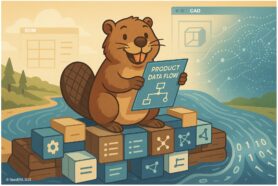
In the interconnected landscape today, manufacturers are realizing the importance of the value of their suppliers. However, at the same time, the supply chain is vulnerable. So, how are manufacturers supposed to launch new, scale production, and create a stable supply chain that is going through many challenges?
In order to achieve better results, manufacturers need to use data to help them make decisions. They need to make better decisions faster. In order to make better decisions, they need to have all the data laid out for them transparently. One partner that is responsible for providing the manufacturer with a lot of data points is their supplier or contract manufacturer.
In a sense, a manufacturer can only be as successful as their lowest-performing supplier. If there is a supplier providing parts with quality defects then your final product will have problems.
Therefore, manufacturers have made it a point to work closely with their suppliers. Manufacturers have been implementing tools, such as digital transformation software that keep them connected with their suppliers.
In this blog, we will go over digital transformation and what it means to you. Also, we will look at how digital transformation can enable supplier visibility.
What is Digital Transformation
Digital transformation is the process of using technology to improve how a business operates. It involves integrating digital tools and strategies to improve efficiency, enhance customer experiences, and stay competitive in your industry.
The goals of digital transformation vary across organizations and industries, but are commonly the following:
Enhancing Operational Efficiency
Digital transformation aims to streamline and automate processes, reduce manual tasks, eliminate mistakes, and optimize resource allocation. This leads to cost savings, improved productivity, and faster time-to-market.
Improving Customer Experiences
By leveraging digital technologies, organizations can create personalized and seamless experiences for their customers. In manufacturing companies, you have a task to get the customer a product at a specific price by a specific date. Having the tools at your disposal will help you to meet all of these tasks.
Improve Decision-Making Skills:
Digital transformation involves capturing, analyzing, and leveraging data to gain valuable insights and drive informed decision-making. It enables organizations to make predictions, identify trends, and optimize strategies based on gathering data.
Empowering Employees
Digital transformation provides employees with the tools, training, and resources they need to work efficiently, collaborate effectively, and make informed decisions. In other words, use digital transformation as a tool to improve your job performance.
Digital Transformation and Supplier Visibility
From the four points above, we learned how digital transformation helps a business, no matter what its industry or department is. But now, let’s look at how digital transformation brings you closer to your supplier.
The goal of introducing digital transformation in your supply chain is to enable collaboration and create visibility within your supply chain. What this means is leveraging the strengths of your supplier while also creating an environment of transparency.
Are we on the Same BOM?
You heard the expression, “Are we on the same page.” While it’s simple, many manufacturers and suppliers are just on different BOMs. Digital transformation ensures that you are not just working on the same BOM but the entire product data is the same by creating a single source of truth for you and your suppliers.
Share Data from Engineering with Suppliers
For manufacturers, how many times has a supplier purchased the wrong part because the BOM was not updated? How many times were the wrong parts purchased because of the incorrect quantities labeled? Or how many hours have you had to wait to get the drawings, STEP files, BOM, or product data from someone? Usually, this is when the fingers are pointed but the problems still existed.
Digital transformation creates an environment that connects engineering with the supply chain. By seamlessly sharing data, it enables transparency and creates clear visibility through the supply chain.
Communicate Changes Effectively
The only constant is change. In manufacturing, parts are also changing. All of these changes need to be taken into account and communicated to the supplier.
Alternative Suppliers or Components
If supply chain vulnerabilities have taught us anything, it’s that we need to diversify our supply chain. This means, having the option to purchase the same part or component from multiple suppliers. In order to do this, you need to have all of this data disposable in your fingerprints.
Other times, it’s not replacing one supplier for another. It’s replacing one component for another because of lead time issues or pricing differences. Having this data accessible will support your supplier in purchasing the correct component when necessary.
Up-to-Date Pricing
For the past few years, we have seen part inflation. The price for nearly every material was going up. Suppliers could only honor part quotes for only a few days to a month. It seemed like each time a supplier would place a PO with a quote from 20 days ago, the supplier would need to reject the PO until the price was adjusted.
How to Move Forward?
If you are looking to improve supplier visibility and collaboration then technology can bring you closer to them. Implementing a company-wide strategy takes time. However, there are steps you can take now. This includes trading Excel files for a data-centric strategy.
OpenBOM is a cloud-based PDM & PLM platform to manage your engineering and manufacturing data. Companies from startups to Fortune 500s use OpenBOM to create a centralized database to bring in, store, and manage their manufacturing data. With this infrastructure, users also use OpenBOM to streamline both their change management and PO processes.
If you need to improve the way you manage your data and processes, share data instantly, or collaborate with contractors and suppliers. contact us today for a free consultation.
Regards,
Jared Haw
Join our newsletter to receive a weekly portion of news, articles, and tips about OpenBOM and our community.










